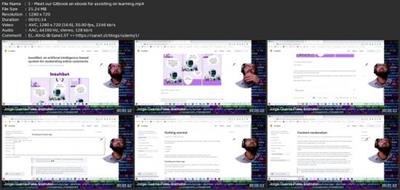O
0

Published 12/2022
MP4 | Video: h264, 1280x720 | Audio: AAC, 44.1 KHz
Language: English | Size: 1.76 GB | Duration: 1h 51m
Getting ready to welcome trollers and alike
MP4 | Video: h264, 1280x720 | Audio: AAC, 44.1 KHz
Language: English | Size: 1.76 GB | Duration: 1h 51m
Getting ready to welcome trollers and alike
What you'll learn
How to use a pretrained model for content moderation
Using Angular Material, basics
Implementing artificila intelligence in Angular
How to use TensorFlowjs (deep learning)
Requirements
No programming experience needed, basics of Angular may be beneficial
Description
Online Content moderation is the process by which one must decide what stays online vs. what should be moderated or even eliminated; no one is happy to be moderated, I was not when I was the target of several online moderations on YouTube, Facebook and Twitter. The "Napalm girl" was a famous case in which Facebook classified as nudity, which is a historical picture."even the prime minister of Norway herself, reposted the photo to Facebook, only to have it quickly removed." Custodians of the Internet: Platforms, Content Moderation, and the Hidden Decisions That Shape Social Media Book by Tarleton GillespieWhat is the best and most efficient way to safely moderate content online?Several programming savvies are doing their best. Like in String Theory, they gather the best, but no practical answer came out yet.On this course, I want to share a trivial case, which was not also easy to solve: direct insult (i.e., calling people names).The bot is a classical pattern recognition: it gives out a number, and you must decide your tolerance for insults. This number, already standard on deep learning, is a sort of properly, loosely speaking.We are going to use two MIT license Google public tools: TensorFlow.js and Angular. The former is a deep learning tool for freely creating smart web application, whereas the latter is a free framework for creating frontend application, no need to create servers.
Overview
Section 1: Preliminaries
Lecture 1 Meet our Gitbook, an ebook for assisting on learning
Lecture 2 Meet our app, a bot for detecting insults
Lecture 3 Meet our github repository
Section 2: Getting started
Lecture 4 Initials
Lecture 5 Installing @tensorflow-models/toxicity: getting ready to be insulted by trollers
Lecture 6 Getting to know the library: a basic parametrization
Lecture 7 Getting to know the library: "******", testing this insult
Section 3: Creating an User Interface using Angular Material
Lecture 8 Getting started
Lecture 9 Getting started, part II
Lecture 10 Using Angular Material to create a card
Lecture 11 Adding a button to our card
Lecture 12 Adding an input for moderation to our card
Lecture 13 Connect button to our logic
Lecture 14 Preparing the code for showing the moderation result from input
Lecture 15 Just some final adjustments, and we are ready to go: "you suck!"
Lecture 16 Closing lines, just a final test
Section 4: Take a pick on our course before buying it!
Lecture 17 Error type I and II on online content moderation: parametrizing @tensorflow-mode
Lecture 18 "****" is a way to insult black people in America; is our bot able to flag it?
Lecture 19 Getting to know me briefly
Angular programmers interested in artificial intelligence,Artificial intelligence practitioners interested in web development,People interested in online content moderation

Download link
rapidgator.net:
You must reply in thread to view hidden text.
uploadgig.com:
You must reply in thread to view hidden text.
nitroflare.com:
You must reply in thread to view hidden text.
1dl.net:
You must reply in thread to view hidden text.
